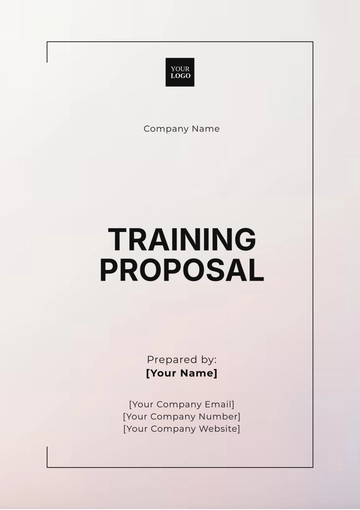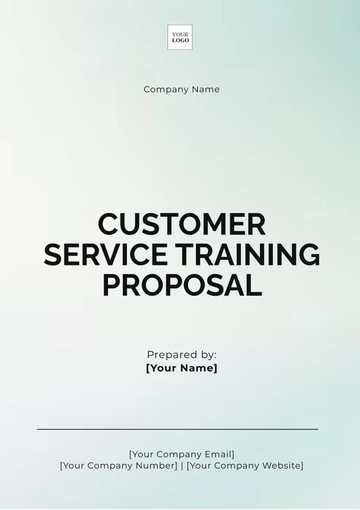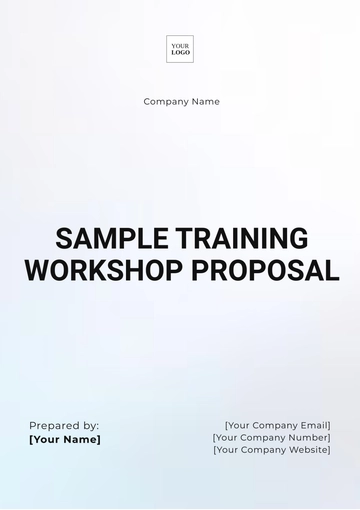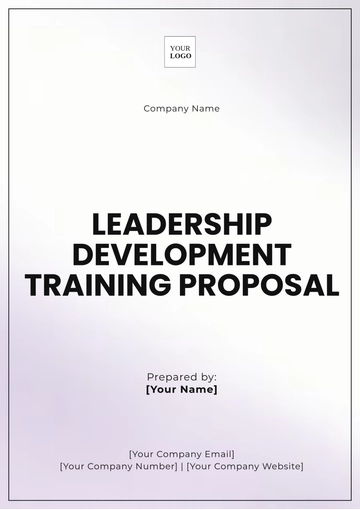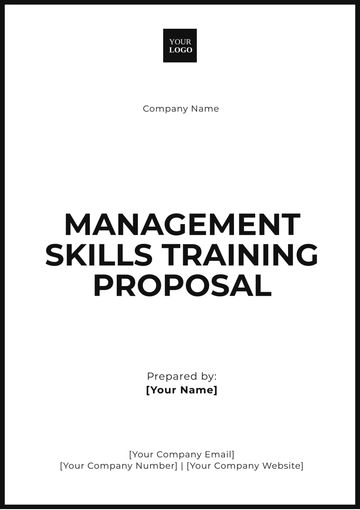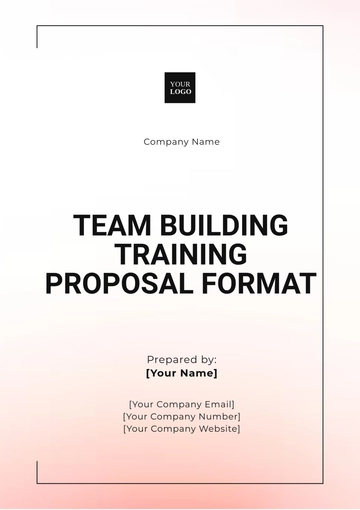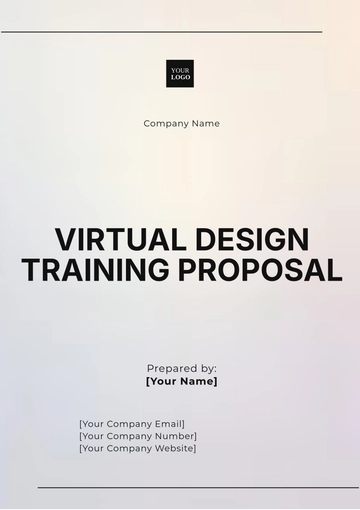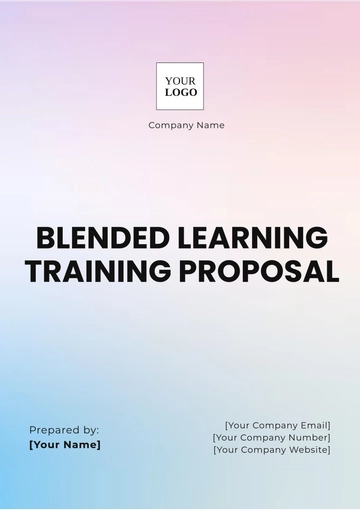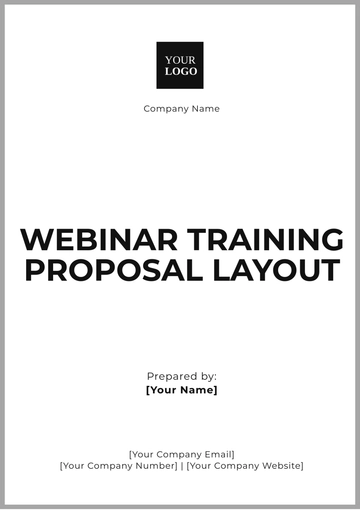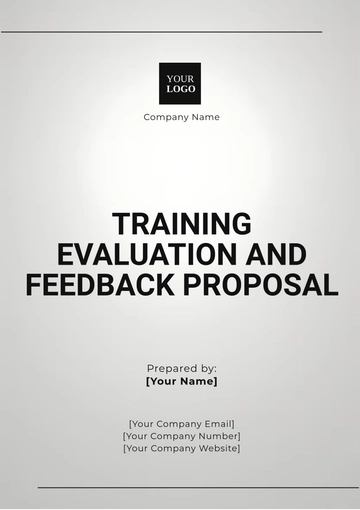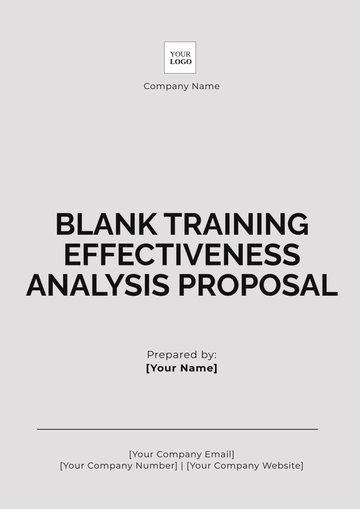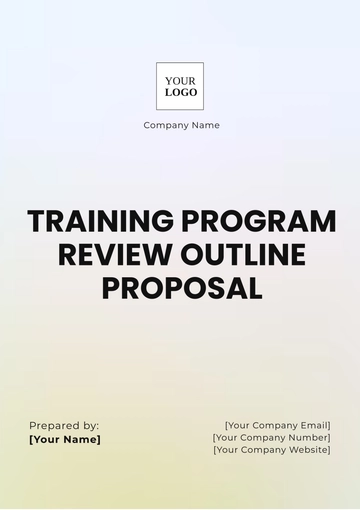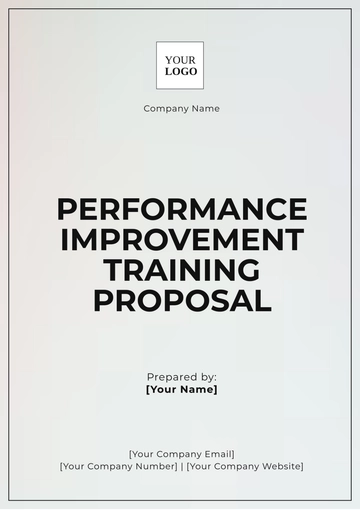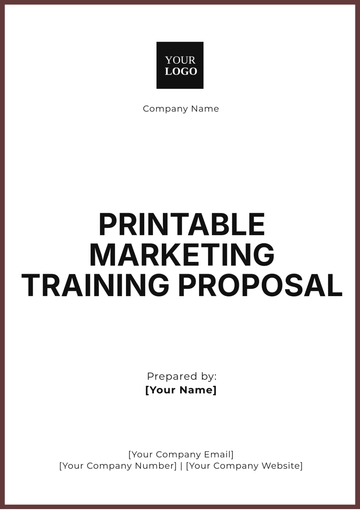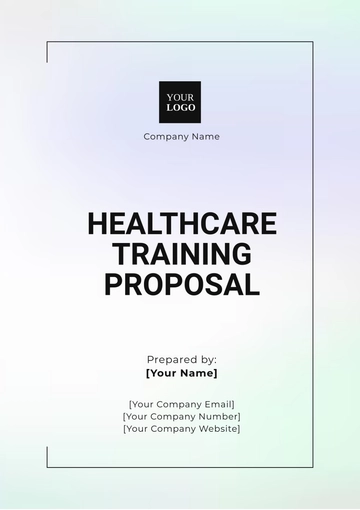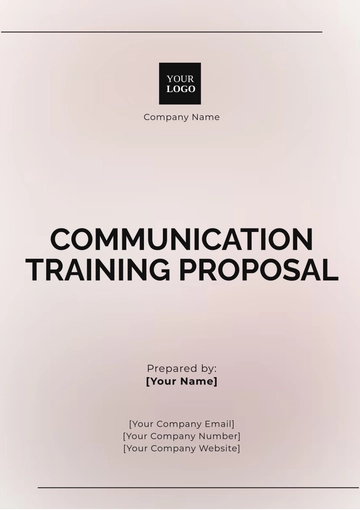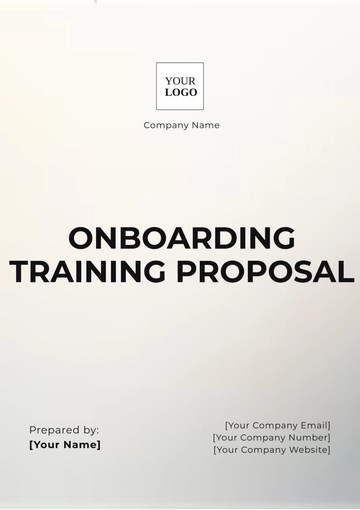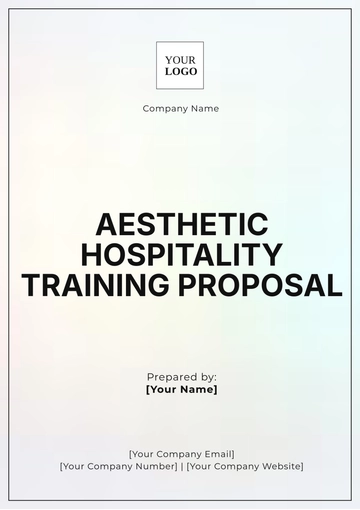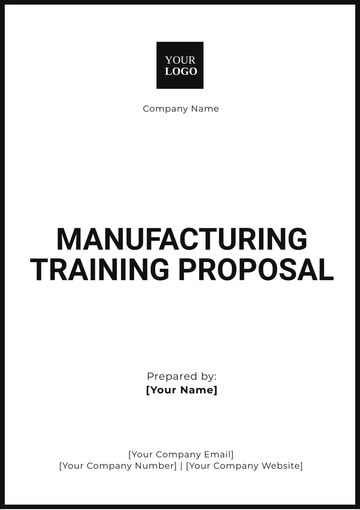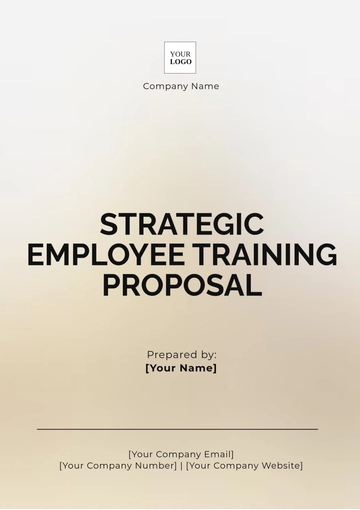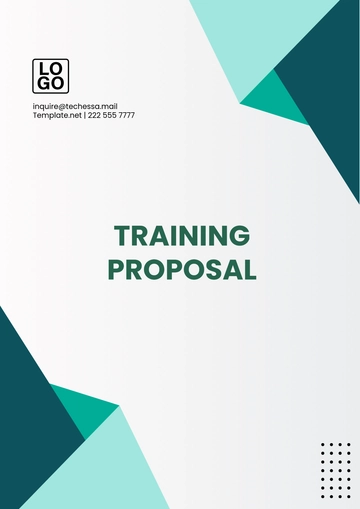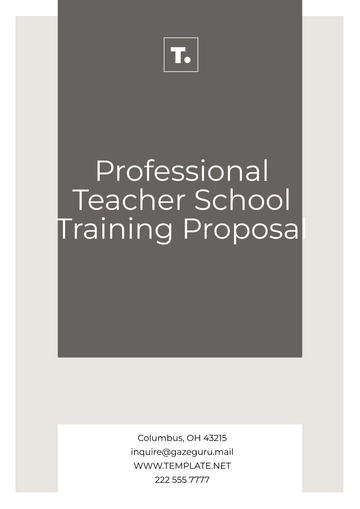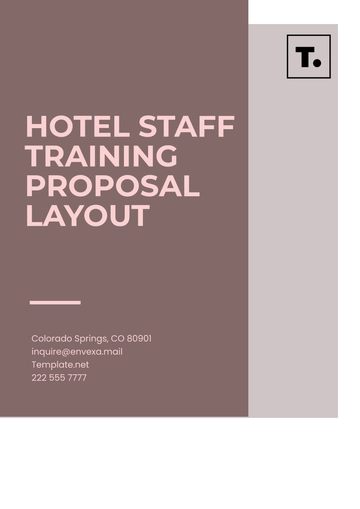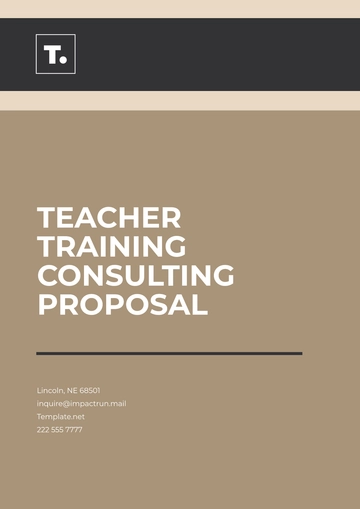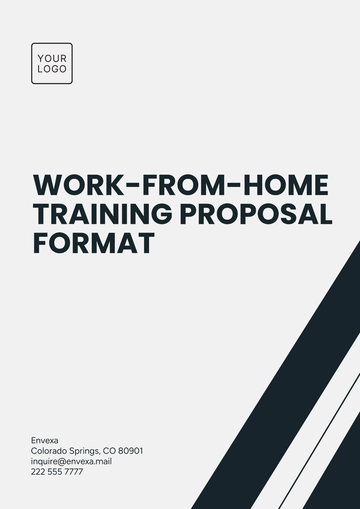Free Spa Training Proposal
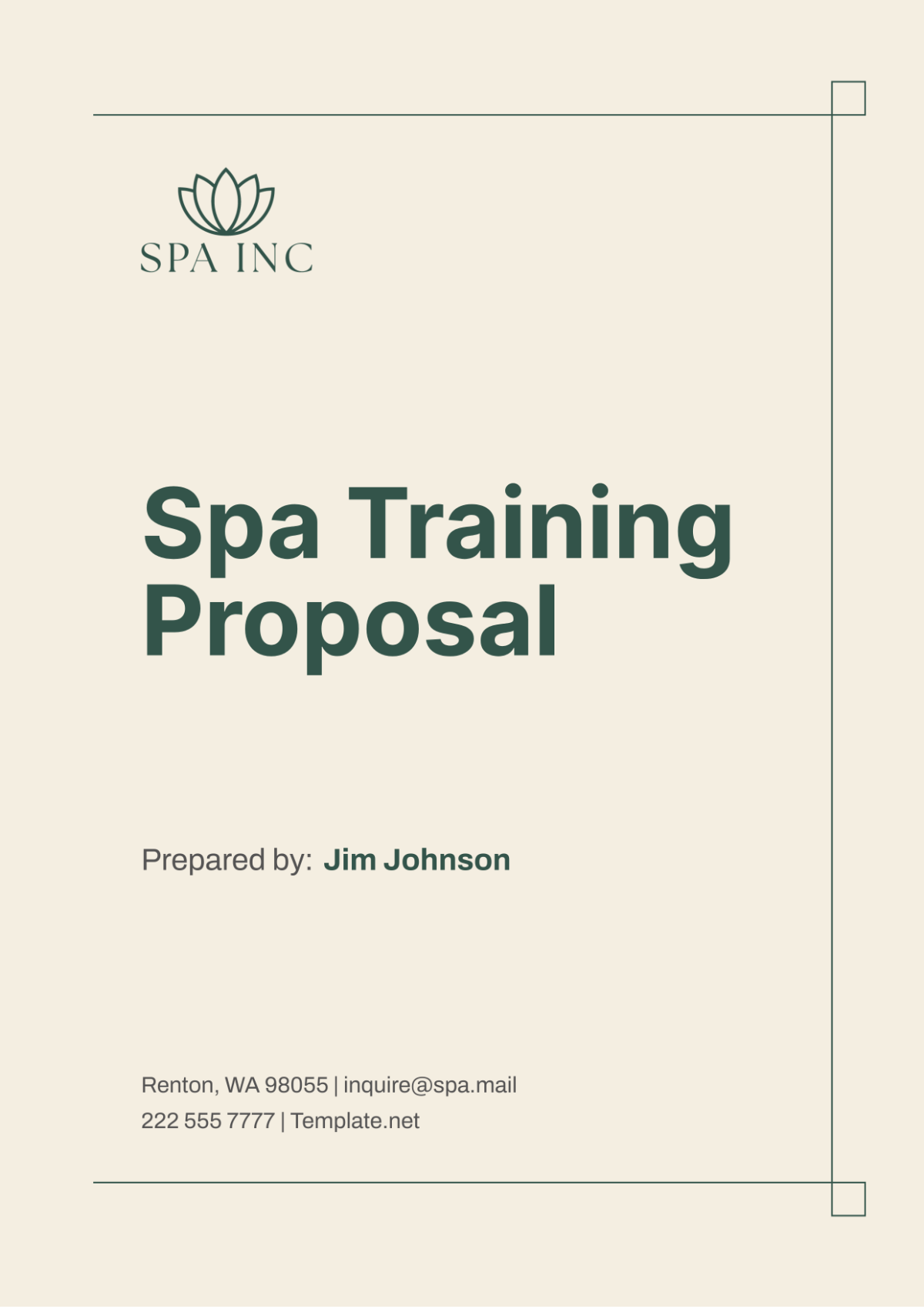
1. Introduction
This Spa Training Proposal outlines a comprehensive training program designed for the staff of [Your Company Name] Spa. Our primary goal is to ensure that all employees are well-equipped with the necessary skills, knowledge, and attitudes to provide exceptional service to our clients. This program is crucial for the professional development of our team members, enabling them to deliver the highest standards of spa services. By investing in our team's development, we aim to enhance the overall guest experience, improve operational efficiency, and maintain a competitive edge in the hospitality industry. The training program is structured to cover various aspects of spa operations, from customer service to technical skills and management, ensuring that our employees are well-rounded professionals.
In today's competitive market, it is imperative that our staff are not only proficient in their technical skills but also excel in customer service and adhere to the highest health and safety standards. This proposal details the specific training modules, delivery methods, and evaluation techniques that will be employed to achieve these objectives. By aligning our training efforts with industry best practices and the latest developments in spa services, we are committed to fostering a culture of continuous improvement and excellence.
2. Objectives
The primary objectives of this training program are to ensure that our staff provide the highest quality of service, remain satisfied and engaged in their roles, comply with all health and safety standards, and continuously develop their professional skills. Achieving these objectives will not only improve the quality of service provided by our staff but also contribute to the overall success and reputation of [Your Company Name] Spa.
Improve the Quality of Service
Improving service quality is paramount to enhancing guest satisfaction and loyalty. This involves training staff to be attentive, responsive, and proactive in meeting guests' needs. The training program will cover various customer service techniques and best practices to ensure that our staff can handle a wide range of guest interactions effectively.
Enhance Employee Satisfaction and Reduce Turnover Rates
Employee satisfaction is closely linked to job performance and retention. By providing opportunities for professional growth and creating a supportive work environment, we aim to boost employee morale and reduce turnover rates. The training program will include modules on stress management, teamwork, and personal development to foster a positive workplace culture.
Ensure Compliance with Health and Safety Standards
Compliance with health and safety regulations is critical in the spa industry. Our training program will ensure that all staff are knowledgeable about hygiene practices, emergency procedures, and ergonomics. This will not only protect our employees and guests but also enhance the spa's reputation for safety and reliability.
Foster a Culture of Continuous Improvement
Continuous improvement is essential for maintaining high standards and staying competitive. The training program will encourage staff to seek ongoing education and stay updated with the latest industry trends and techniques. This culture of lifelong learning will ensure that our staff are always at the forefront of spa service excellence.
Equip Employees with Advanced Skills
Equipping employees with advanced skills in customer service, technical spa treatments, and management is vital for their professional development and the spa's success. The training program will include specialized modules on various spa treatments, leadership skills, and customer interaction techniques to ensure that our staff are well-rounded professionals.
3. Training Needs Analysis
Before implementing the training program, a thorough needs analysis was conducted to identify specific areas requiring improvement. This analysis involved collecting data from various sources to gain a comprehensive understanding of our current training gaps and areas of opportunity.
Employee Surveys
Employee surveys were distributed to gather feedback on current skills, job satisfaction, and areas where employees feel they need more training. The surveys revealed that while most employees felt confident in their basic skills, there was a significant demand for advanced training in specific treatments and customer service techniques.
Customer Feedback
Customer feedback was analyzed to identify common service issues and areas for enhancement. Guests highlighted the need for more personalized services and faster response times to their requests. This feedback will inform the customer service training modules to ensure that we meet and exceed guest expectations.
Performance Reviews
Performance reviews were evaluated to identify skill gaps and training needs. The reviews showed that while technical skills were generally strong, there were opportunities for improvement in areas such as team collaboration and management. These findings will guide the development of targeted training modules to address these gaps.
Industry Standards
Industry benchmarks and standards were reviewed to ensure our training program aligns with best practices. This analysis revealed the importance of staying updated with the latest techniques and technologies in spa services. The training program will incorporate these best practices to ensure our staff are equipped with the most current and effective skills.
4. Training Program Structure
The training program is divided into several key modules, each focusing on different aspects of spa operations and services. The program will be delivered over a six-month period, with regular assessments to measure progress and effectiveness. Each module is designed to build on the previous one, ensuring a comprehensive and cohesive training experience.
1. Orientation and Onboarding
Objective: Introduce new hires to the company culture, policies, and procedures.
Content:
Welcome and Introduction to [Your Company Name] Spa: An overview of the company's history, mission, and values.
Company Mission, Vision, and Values: Understanding the core principles that guide our operations.
Overview of Spa Services and Facilities: A detailed look at the services offered and the facilities available at the spa.
Health and Safety Policies: Essential information on maintaining a safe and hygienic environment.
Employee Handbook and Code of Conduct: Guidelines on expected behavior and professional standards.
Duration: 1 week
2. Customer Service Excellence
Objective: Equip staff with the skills to deliver exceptional customer service.
Content:
Communication Skills: Techniques for effective communication with guests and colleagues.
Handling Complaints and Difficult Customers: Strategies for managing challenging situations and resolving issues amicably.
Creating Memorable Guest Experiences: Ways to exceed guest expectations and create lasting impressions.
Understanding Customer Needs and Preferences: Methods for identifying and addressing the specific needs of each guest.
Duration: 2 weeks
3. Technical Skills Training
Objective: Provide hands-on training in various spa treatments and services.
Content:
Massage Techniques: Training in different types of massages, including Swedish, deep tissue, and aromatherapy.
Facial Treatments and Skincare: Techniques for providing effective and relaxing facial treatments.
Body Treatments: Training in body scrubs, wraps, and other rejuvenating treatments.
Nail Services: Comprehensive training in manicure and pedicure techniques.
Use of Spa Equipment and Products: Instructions on how to use various spa equipment and products safely and effectively.
Duration: 4 weeks
4. Health and Safety Compliance
Objective: Ensure compliance with health and safety regulations and best practices.
Content:
Hygiene and Sanitation Procedures: Best practices for maintaining a clean and hygienic spa environment.
First Aid and Emergency Response: Training in basic first aid and emergency procedures.
Ergonomics and Injury Prevention: Techniques for preventing work-related injuries and promoting staff well-being.
Regulatory Compliance and Record Keeping: Understanding and adhering to industry regulations and maintaining accurate records.
Duration: 2 weeks
5. Management and Leadership
Objective: Develop leadership and managerial skills for supervisory staff.
Content:
Leadership Styles and Techniques: Exploring different leadership styles and their applications.
Team Building and Motivation: Strategies for fostering a collaborative and motivated team environment.
Conflict Resolution: Techniques for resolving conflicts and maintaining a positive workplace atmosphere.
Performance Management and Appraisals: Methods for conducting effective performance reviews and providing constructive feedback.
Duration: 3 weeks
6. Continuous Improvement and Professional Development
Objective: Foster a culture of lifelong learning and continuous improvement.
Content:
Setting Personal and Professional Goals: Techniques for setting and achieving meaningful goals.
Time Management and Productivity: Strategies for managing time effectively and increasing productivity.
Stress Management and Well-being: Methods for managing stress and promoting overall well-being.
Ongoing Education and Certification Opportunities: Encouraging staff to pursue further education and certifications to enhance their skills.
Duration: Ongoing
5. Training Schedule
A well-structured training schedule is crucial for ensuring that all training modules are delivered effectively and within the stipulated time frame. Below is the detailed schedule for the six-month training program at [Your Company Name] Spa:
Week | Module | Duration | Trainer | Location |
|---|---|---|---|---|
1 | Orientation and Onboarding | 1 week | [Trainer Name] | Conference Room A |
2-3 | Customer Service Excellence | 2 weeks | ||
4-7 | Technical Skills Training | 4 weeks | ||
8-9 | Health and Safety Compliance | 2 weeks | ||
10-12 | Management and Leadership | 3 weeks | ||
Ongoing | Continuous Improvement and Development | Continuous |
Week 1: Orientation and Onboarding
The first week will focus on familiarizing new employees with the company culture, policies, and procedures. The orientation will include a comprehensive introduction to [Your Company Name] Spa, its mission, vision, values, and an overview of the spa services and facilities. This module will also cover health and safety policies and provide employees with the employee handbook and code of conduct.
Weeks 2-3: Customer Service Excellence
This two-week module aims to equip staff with the skills necessary to deliver exceptional customer service. Training will cover communication skills, handling complaints and difficult customers, creating memorable guest experiences, and understanding customer needs and preferences. This module will be interactive, involving role-playing and real-life scenarios to ensure practical understanding.
Weeks 4-7: Technical Skills Training
Over four weeks, staff will receive hands-on training in various spa treatments and services, including massage techniques, facial treatments, body treatments, and nail services. This module will be highly practical, with sessions conducted in treatment rooms to simulate real-world scenarios. Trainers will demonstrate techniques, followed by supervised practice sessions for staff.
Weeks 8-9: Health and Safety Compliance
Ensuring that staff comply with health and safety regulations is paramount. This two-week module will cover hygiene and sanitation procedures, first aid and emergency response, ergonomics and injury prevention, and regulatory compliance and record-keeping. The training will include practical demonstrations and drills to reinforce learning.
Weeks 10-12: Management and Leadership
For supervisory staff, this three-week module will focus on developing leadership and managerial skills. Topics will include leadership styles and techniques, team building and motivation, conflict resolution, and performance management and appraisals. Interactive workshops and case studies will be used to enhance learning and application of these skills.
Ongoing: Continuous Improvement and Development
Continuous improvement is a core principle at [Your Company Name] Spa. This module, which runs concurrently with other training activities, will cover setting personal and professional goals, time management and productivity, stress management and well-being, and ongoing education and certification opportunities. Various trainers will conduct these sessions, and topics will be revisited regularly to reinforce learning.
6. Training Delivery Methods
To accommodate different learning styles and ensure comprehensive coverage of all topics, the training will be delivered using a mix of methods. This approach will enhance engagement, retention, and application of knowledge.
Classroom Instruction
Traditional lectures and presentations will cover theoretical aspects of the training modules. These sessions will provide foundational knowledge and introduce key concepts.
Hands-On Training
Practical sessions in treatment rooms will allow employees to apply what they have learned in a real-world setting. These sessions will be supervised by experienced trainers who will provide feedback and guidance.
E-Learning Modules
Online courses will offer flexible learning opportunities, enabling staff to learn at their own pace. E-learning modules will include interactive content, quizzes, and videos to enhance understanding.
Workshops and Seminars
Interactive sessions will encourage participation and engagement. Workshops and seminars will involve group activities, discussions, and practical exercises to reinforce learning.
Guest Speakers and Industry Experts
Inviting guest speakers and industry experts will provide staff with insights and knowledge from experienced professionals. These sessions will cover current trends, best practices, and innovations in the spa industry.
7. Evaluation and Assessment
To measure the effectiveness of the training program, we will use a combination of evaluation methods. This will ensure that the training objectives are being met and that staff are continuously improving.
Pre- and Post-Training Assessments
Tests and quizzes will be administered before and after training sessions to measure knowledge and skill improvements. These assessments will help identify areas where additional training may be needed.
Employee Feedback
Surveys and feedback forms will be distributed to gather participant opinions on the training experience. This feedback will provide valuable insights into the effectiveness of the training and highlight areas for improvement.
Customer Feedback
Guest satisfaction scores and reviews will be monitored to assess service improvements. Customer feedback will be analyzed to identify trends and measure the impact of the training on guest experiences.
Performance Metrics
Key performance indicators (KPIs) such as service delivery time, client retention rates, and employee productivity will be tracked. Regularly monitoring these metrics will help us evaluate the effectiveness of the training program and make necessary adjustments.
Evaluation Method | Purpose | Frequency |
|---|---|---|
Pre- and Post-Training Assessments | Measure knowledge and skill improvements | Before and after training sessions |
Employee Feedback | Gather participant opinions on the training experience | After each training module |
Customer Feedback | Assess service improvements through guest satisfaction scores and reviews | Monthly |
Performance Metrics | Track KPIs such as service delivery time, client retention rates, and employee productivity | Quarterly |
8. Budget
The estimated budget for the six-month training program is detailed below. This budget covers all necessary expenses to ensure a high-quality training experience for all participants.
Expense Category | Estimated Cost |
|---|---|
Training Materials | $5,000 |
Trainer Fees | $20,000 |
E-Learning Platform Subscription | $3,000 |
Facility Rental and Setup | $2,000 |
Employee Overtime Compensation | $10,000 |
Miscellaneous Expenses | $2,000 |
Total | $42,000 |
Detailed Budget Breakdown:
Training Materials: This includes the cost of manuals, handouts, and other instructional materials needed for the training sessions.
Trainer Fees: Fees for professional trainers who will conduct the training sessions, including any guest speakers and industry experts.
E-Learning Platform Subscription: Subscription fees for online training platforms that will provide additional learning resources and modules.
Facility Rental and Setup: Costs associated with renting training rooms and setting up the necessary equipment and materials.
Employee Overtime Compensation: Compensation for employees who participate in training sessions outside of their regular working hours.
Miscellaneous Expenses: Additional costs such as refreshments, administrative expenses, and other unforeseen expenses related to the training program.
By carefully managing these expenses, we can ensure that the training program is cost-effective while still delivering high-quality, impactful training for our staff at [Your Company Name] Spa.
9. Conclusion
Investing in the professional development of our staff is crucial to maintaining the high standards of service that [Your Company Name] Spa is known for. This comprehensive training program is designed to equip our employees with the skills and knowledge necessary to excel in their roles and provide exceptional experiences for our guests. We are confident that this initiative will lead to improved service quality, enhanced employee satisfaction, and increased client loyalty.
For further information or questions regarding this training proposal, please contact:
[Your Name]
Training Coordinator
[Your Company Name]
[Your Company Email]
[Your Company Number]
- 100% Customizable, free editor
- Access 1 Million+ Templates, photo’s & graphics
- Download or share as a template
- Click and replace photos, graphics, text, backgrounds
- Resize, crop, AI write & more
- Access advanced editor
Elevate your spa training sessions effortlessly with the Spa Training Proposal Template from Template.net. This fully editable and customizable document, enhanced by our AI editor tool, ensures precision and professionalism. Tailor every detail to fit your unique needs and deliver compelling proposals that captivate clients and secure approvals. Streamline your workflow and enhance your spa's effectiveness!
You may also like
- Business Proposal
- Research Proposal
- Proposal Request
- Project Proposal
- Grant Proposal
- Photography Proposal
- Job Proposal
- Budget Proposal
- Marketing Proposal
- Branding Proposal
- Advertising Proposal
- Sales Proposal
- Startup Proposal
- Event Proposal
- Creative Proposal
- Restaurant Proposal
- Blank Proposal
- One Page Proposal
- Proposal Report
- IT Proposal
- Non Profit Proposal
- Training Proposal
- Construction Proposal
- School Proposal
- Cleaning Proposal
- Contract Proposal
- HR Proposal
- Travel Agency Proposal
- Small Business Proposal
- Investment Proposal
- Bid Proposal
- Retail Business Proposal
- Sponsorship Proposal
- Academic Proposal
- Partnership Proposal
- Work Proposal
- Agency Proposal
- University Proposal
- Accounting Proposal
- Real Estate Proposal
- Hotel Proposal
- Product Proposal
- Advertising Agency Proposal
- Development Proposal
- Loan Proposal
- Website Proposal
- Nursing Home Proposal
- Financial Proposal
- Salon Proposal
- Freelancer Proposal
- Funding Proposal
- Work from Home Proposal
- Company Proposal
- Consulting Proposal
- Educational Proposal
- Construction Bid Proposal
- Interior Design Proposal
- New Product Proposal
- Sports Proposal
- Corporate Proposal
- Food Proposal
- Property Proposal
- Maintenance Proposal
- Purchase Proposal
- Rental Proposal
- Recruitment Proposal
- Social Media Proposal
- Travel Proposal
- Trip Proposal
- Software Proposal
- Conference Proposal
- Graphic Design Proposal
- Law Firm Proposal
- Medical Proposal
- Music Proposal
- Pricing Proposal
- SEO Proposal
- Strategy Proposal
- Technical Proposal
- Coaching Proposal
- Ecommerce Proposal
- Fundraising Proposal
- Landscaping Proposal
- Charity Proposal
- Contractor Proposal
- Exhibition Proposal
- Art Proposal
- Mobile Proposal
- Equipment Proposal
- Student Proposal
- Engineering Proposal
- Business Proposal
